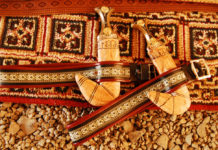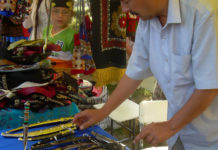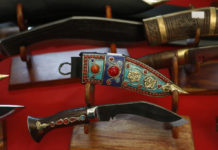The khanjar industry occupies a key place in the history of Oman. The Omani khanjar is characterized by a rich sense of aesthetics and reflects the unique taste of the country’s authentic art, deeply rooted in its history.
Oman has been known for the khanjar craft industry for thousands of years and it remains as a common weapon in Oman, as well as a valuable symbol of its heritage. It is regarded as an authentic piece that the present generation is keen on passing onto their children. The khanjar is also a symbol of manhood and pride among Omani men as it is a part of men’s traditional Omani dress. In the past, men used to wear it on a daily basis and today it is usually worn in most official and social events such as national celebrations and weddings.
The Omani khanjar consists of three essential parts: the hilt, the sheet and the blade. The hilt is made of ivory, horn or sandalwood and its price depends on the material it is made of. The second part is the sheet which is made of a curved piece of wood covered with silver. The sheets shape the real design of khanjar. The third part is the blade in which the hilt is stocked. The blade is made of a sharp iron.

The khanjar comprises the following components:
- Alqarn (horn or sandalwood) is the upper part, which is sometimes covered with silver. Its price depends on the material it is made of, and it is the most expensive component of khanjar.
- Al touq, which is directly under alqarn, where the blade is fixed, followed by al sadr or al tams (silver rings).
- Al qataa, which is the body of the blade and the belt made of leather ornamented with silver threads, or silver sheets with beautiful inscriptions.
- The belt is made of leather skillfully ornamented with silver threads.
What distinguishes the Omani khanjar is that its designs differ from one region to another in the Sultanate. The major designs of the khanjar come in different styles such as Saidiyah, Dakhiliyah (Omaniyah) and Sharqiyah (Suriyah). These are the three fundamental designs, which distinguish the Omani khanjar from other types of khanjars in other Gulf countries. However, there are numerous variations of khanjar derived from personal choices of the craftspersons and contemporary trends. Khanjars are made in different regions and wilayats in the Sultanate. The different types of khanjars are named after the regions in which they are made and vary according to size, shape, type of metal and the cover. The Saidiyah khanjar (named after Sultan said bin Sultan, who became the Sultan in 1804, worn straight in the centre by the Al said royal family with the Saidia turban and distinguished by silver handle) has a narrow hilt covered with silver and it is the largest and most expensive one. It is the most popular and favorite type of khanjars among Omani people. The Dakhiliyah khanjar (the Al Nizwani Khangar, worn diagonally) has a very broad handle of ivory and a sheet which is ornamented with artistic designs of silver. The Sharqiyah or the Suriyah khanjar (as it is named after the area of its making) differentiates from other types as it is smaller in size and lighter in weight. However, the khanjars from Sur are very elegant with their distinctive designs. (Asmaa Malik: 2017).
Al Batini khanjar is named after the area of its making (Al Batinah). Others call it Al Saheliah as its makers come from the coastal states in north Al Batinah. Al Batini khanjar is smaller than the Al Nizwani khanjar and is worn on the left side. (Types of Omani Khanjars: 2017)
The Omani khanjar is distinguished from other types of daggers elsewhere in the world by its artistic designs made of silver and precious hilts. It represents the ancient Omani culture and proficiency of the Omani craftsmen inherited through generations.
The khanjar’s price is determined by the raw material it is made of, usually iron, silver or gold. The prices also vary depending on the size of the ivory or horn of the hilt. The sheet of the khanjar represents the craftsmanship of the silversmith and how skillful he is. Silver khanjars are the most common, especially for making the dagger handle. The blade’s case also determines a dagger’s price.
Although the number of khanjar makers is in decline these days, the demand remains high as many families preserve the tradition of wearing khanjar on important occasions.
Further reading
Malik, Asmaa. 2017. “Omani Dagger: Khanjar, a symbol of male elegance”. Global Arab Network. Retrieved May 17 2017 from: http://www.english.globalarabnetwork.com/GCC-Business/khanjar-a-symbol-of-male-elegance.html
Types of Omani Khanjars (daggers). Retrieved May 31 2017 from: http://khanjar.om/Types.html






WAs in Oman last week, saw it in many places even on flag, know I know some story behind. Thak you for this info